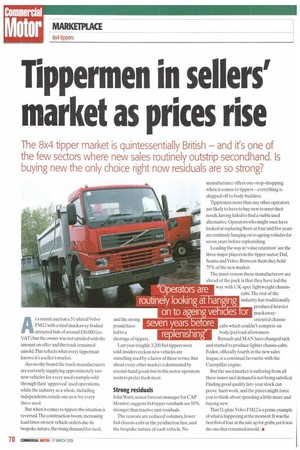Tippermen in sellers' market as prices rise
Page 72

If you've noticed an error in this article please click here to report it so we can fix it.
The 8x4 tipper market is quintessentially British — and it's one of the few sectors where new sales routinely outstrip secondhand. Is buying new the only choice right now residuals are so strong?
At a recent auction a 51-plated Volvo FM12 with a steel muckaway bodied attracted bids of around £30,000 (exVAT) but the owner was not satisfied with the amount on offer and the truck remained unsold.This reflects what every tipperman knows: it's a seller's market.
Across the board the truck manufacturers are currently supplying approximately two new vehicles for every used example sold through their 'approved' used operations, while the industry as a whole, including independents, retails one new for every three used.
But when it comes to tippers the situation is reversed. The construction boom, increasing lead times on new vehicle orders due its bespoke nature, the rising demand for steel, and the strong pound have led to a shortage of tippers.
Last year roughly 3,200 8x4 tippers were sold: insiders reckon new vehicles are outselling used by a factor of three to two. Just about every other market is dominated by second-hand goods but in this sector operators seem to prefer fresh meat.
Strong residuals John Watts, senior forecast manager for CAP Monitor, suggests 8x4 tipper residuals are 10% stronger than tractive unit residuals.
The reasons are reduced volumes, fewer 8x4 chassis-cabs in the production line, and the bespoke nature of each vehicle. No manufacturer offers one-stop-shopping when it comes to tippers — everything is shipped off to body builders.
Tippermen more than any other operators are likely to have to buy new to meet their needs, having failed to find a viable used alternative. Operators who might once have looked at replacing fleets at four and five years are routinely hanging on to ageing vehicles for seven years before replenishing.
Leading the way in 'value retention' are the three major players in the tipper sector: Daf, Scania and Volvo. Between them they hold 75% of the new market.
The main reason these manufacturers are ahead of the pack is that they have led the way with UK-spec lightweight chassiscabs.The rest of the industry has traditionally produced heavier muckawayoriented chassiscabs which couldn't compete on body/payload allowances.
Renault and MAN have changed tack and started to produce lighter chassis-cabs; Foden, officially fourth in the new sales league, is a continual favourite with the Caterpillar engine.
But the used market is suffering from all these issues and demand is not being satisfied. Finding good quality late-year stock can prove hard work, and the prices might force you to think about spending a little more and buying new.
That 51-plate VolvoFM12 is a prime example of what is happening at the moment. It was the best 8x4 of four at the sale up for grabs,yet it was the one that remained unsold. Ir










































































































































































































